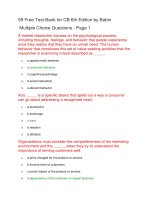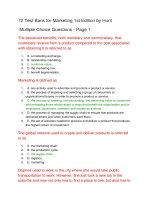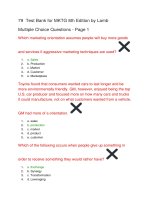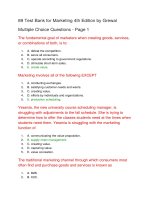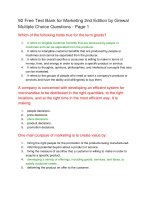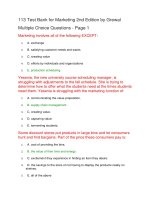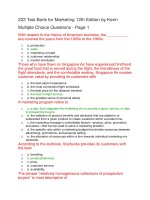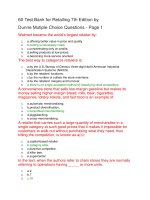Test bank for SPEAK 4th edition by verderber
Bạn đang xem bản rút gọn của tài liệu. Xem và tải ngay bản đầy đủ của tài liệu tại đây (154.72 KB, 6 trang )
Test Bank for SPEAK 4th Edition by Verderber
Full
file at />Name:
Class:
Date:
Chapter 01. Foundations of Public Speaking
1. 24. Ethics are a set of moral principles that a society, group, or individual hold that differentiate right from wrong and
good behavior from bad behavior.
a. True
b. False
ANSWER: False
2. 25. Feedback cannot be expressed nonverbally.
a. True
b. False
ANSWER: False
3. 26. Intrapersonal communication refers to the communication between two people.
a. True
b. False
ANSWER: False
4. 27. Communication through newspapers, magazines, and blogs are examples of small group communication.
a. True
b. False
ANSWER: False
5. 28. Exigence is “something that a situation demands or makes urgently necessary and that puts pressure on the people
involved.”
a. True
b. False
ANSWER: False
6. 29. Tailoring a speech once prepared is not advisable.
a. True
b. False
ANSWER: False
7. 30. Listener-relevance links are statements informing listeners of how and why they should be interested in or care
about an idea.
a. True
b. False
ANSWER: False
Copyright Cengage Learning. Powered by Cognero.
Full file at />
Page 1
Test Bank for SPEAK 4th Edition by Verderber
Full
file at />Name:
Class:
Date:
Chapter 01. Foundations of Public Speaking
8. 31. Microstructure is the overall organizational framework used to present your speech content.
a. True
b. False
ANSWER: False
9. 32. Effective speakers do not use a conversational style of speaking.
a. True
b. False
ANSWER: False
10. 33. Poised speakers make eye contact with their audience.
a. True
b. False
ANSWER: False
11. 1. A(n) _____ is a body of general knowledge needed to effectively participate in a democratic society.
a. liberal art
b. government
c. executive assembly
d. political party
ANSWER: a
12. 2. Public speaking is a liberal art because:
a. public speaking is a highly informal method of communication which does not require prior preparation.
b. public speaking knowledge and skills are fundamental to participating effectively in a democratic society.
c. public speaking knowledge and skills hold relevance to only a handful of professions and fields of study.
d. public speaking allows a speaker to use and quote any content without citing the author.
ANSWER: b
13. 3. Which of the following statements is true about the formal study of public speaking?
a. It teaches us not what to think but how to think.
b. It focuses on eliminating critical thinking.
c. It gives importance to verbal rather than nonverbal cues.
d. It holds little relevance for democratic societies.
ANSWER: a
Copyright Cengage Learning. Powered by Cognero.
Full file at />
Page 2
Test Bank for SPEAK 4th Edition by Verderber
Full
file at />Name:
Class:
Date:
Chapter 01. Foundations of Public Speaking
14. 4. The formal study of public speaking:
a. excludes the nonverbal component of communication.
b. encourages individuals to be simplistic in their approach when collecting information.
c. treats communication as a one-way process.
d. helps us learn to think critically.
ANSWER: d
15. 5. Public speaking empowers us to:
a. use informal means of communication.
b. engage in a one-way communication.
c. achieve our career goals.
d. impose our ideas on others.
ANSWER: c
16. 6. _____ is passing off the ideas, words, or created works of another as one’s own by failing to credit the source.
a. Gazetting
b. Plagiarism
c. Deliberation
d. Bandwagoning
ANSWER: b
17. 7. Which of the following demonstrates unethical behavior of a speaker?
a. Refraining from using humor
b. Engaging in plagiarism
c. Practicing what he or she preaches
d. Reporting all sides of an issue
ANSWER: b
18. 8. Which of the following is true of ethical public speakers?
a. They use informal communication at public events.
b. They report only their perception of an issue.
c. They engage in plagiarism.
d. They practice what they preach.
ANSWER: d
Copyright Cengage Learning. Powered by Cognero.
Full file at />
Page 3
Test Bank for SPEAK 4th Edition by Verderber
Full
file at />Name:
Class:
Date:
Chapter 01. Foundations of Public Speaking
19. 9. Martha, an environmentalist, delivers a speech at an event on the harmful environmental effects of not recycling
glass and plastic. However, on her way back home, she discards an empty plastic water bottle on the street. In this
scenario, which of the following ethical responsibilities of public speaking did Martha fail to meet?
a. Behaving fairly
b. Acting with integrity
c. Being honest
d. Demonstrating respect
ANSWER: b
20. 10. Identify an accurate statement about ethical communicators.
a. They give little importance to nonverbal cues.
b. They impose their views on others.
c. They engage in plagiarism.
d. They attempt to act impartially.
ANSWER: d
21. 11. Kevin is an environmentalist who is highly concerned about global warming. On world environment day, he
delivers a speech explaining the reasons for global warming and what common people can do to alleviate global
warming. In the context of public speaking as a type of communication, Kevin plays the role of a _____.
a. decoder
b. sender
c. receiver
d. facilitator
ANSWER: b
22. 12. _____ are participants who interpret the messages sent by others.
a. Encoders
b. Senders
c. Receivers
d. Facilitators
ANSWER: c
23. 13. Anna, a sociology student, is eager to attend a lecture by a renowned sociologist at her university. She reserves a
seat for the lecture. In the context of public speaking as a type of communication, Anna will play the role of a _____
during the lecture.
a. encoder
b. sender
c. receiver
d. facilitator
ANSWER: c
Copyright Cengage Learning. Powered by Cognero.
Full file at />
Page 4
Test Bank for SPEAK 4th Edition by Verderber
Full
file at />Name:
Class:
Date:
Chapter 01. Foundations of Public Speaking
24. 14. _____ consists of the reactions and responses sent by receivers to let the sender know how the message is being
interpreted.
a. Feedback
b. Virtual presence
c. Interference
d. Noise
ANSWER: a
25. 15. Which of the following is true of virtual presence?
a. It can be accomplished through videoconferencing.
b. It eliminates physical and psychological noise.
c. It facilitates nonverbal communication more than verbal communication.
d. It requires the sender and the receiver to be present in the same location.
ANSWER: a
26. 16. Which of the following is an example of small group communication?
a. Communication among four members of a family
b. Communication between two people arguing about something
c. Communication between a lecturer and a class of fifty students
d. Communication among 100 friends on a social networking site
ANSWER: a
27. 17. _____ is the composite of the speaker, audience, and occasion.
a. The rhetorical situation
b. Noise
c. The exigence
d. Channel interference
ANSWER: a
28. 18. John, a technology expert, is asked to deliver a speech on technology development. In order to understand the
diversity and demographics of the participants, he decides to request everyone to fill in a form. In this scenario, what
concept does John’s decision illustrate?
a. Plagiarism
b. Channel interference
c. Feedback
d. Audience analysis
ANSWER: d
Copyright Cengage Learning. Powered by Cognero.
Full file at />
Page 5
Test Bank for SPEAK 4th Edition by Verderber
Full
file at />Name:
Class:
Date:
Chapter 01. Foundations of Public Speaking
29. 19. Rohit, a famous businessman, is invited as a chief guest to a graduation ceremony in a college. When he learns
that the majority of the audience is from an engineering background, he narrates stories of some successful engineers.
In this scenario, Rohit demonstrates _____.
a. intrapersonal communication
b. audience segmentation
c. audience adaptation
d. small group communication
ANSWER: c
30. 20. Jason, a popular football player, is about to deliver a speech at the inauguration of the annual sports day of a
college. The audience is seated in the auditorium of the college. In this scenario, the inauguration event and the
college auditorium form the _____ for Jason to deliver the speech.
a. occasion
b. noise
c. exigence
d. virtual presence
ANSWER: a
31. 21. Sonia is a math scholar and is addressing a gathering of undergraduate students. She presents one of her theorems
for which she has gained worldwide recognition. Sonia supports her theorem using mathematical derivations. In this
scenario, Sonia uses the rhetorical appeal of _____.
a. lithos
b. pathos
c. ethos
d. logos
ANSWER: d
32. 22. Which of the following is true of macrostructure?
a. It is more important for essays than speeches.
b. Introduction is a part of an effective macrostructure.
c. Transition statements are not included in it.
d. It refers to the specific language and style used while speaking.
ANSWER: b
33. 23. Which of the following is true of intelligible speakers?
a. They tend to construct long sentences when delivering a speech.
b. They use a rate, volume, and pitch that is easily understood.
c. They use a monotone and a passive style of delivering speech.
d. They use jargon extensively.
ANSWER: b
Copyright Cengage Learning. Powered by Cognero.
Full file at />
Page 6
